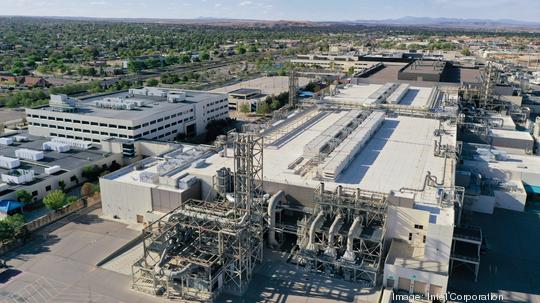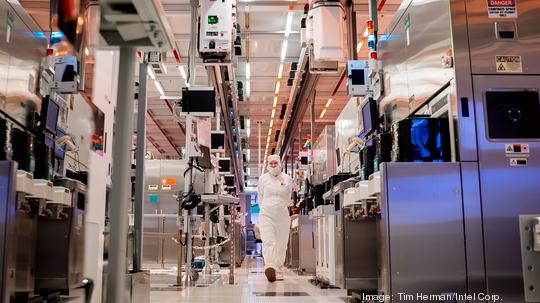
Excitement was high in May following Intel’s multibillion-dollar expansion announcement at Rio Rancho.
The company plans to invest $3.5 billion and retrofit its operations, as well as create 700 jobs at the same manufacturing facilities it previously eliminated thousands of jobs at over the past few decades.
While one piece of a larger puzzle, Intel’s plans might be the thing that allows New Mexico to grow the semiconductor sector.
Workforce
The economic ripple effect of Intel has already played out here in some capacity.
In 1995, Japan-based semiconductor component producer SUMCO brought a semiconductor wafer operation to Albuquerque. It used to do work for Intel, but the computer chip giant eventually moved onto other types of semiconductor tech, reducing the need for SUMCO’s capabilities.
But SUMCO remains local, supporting the automotive, cell phone and appliance industries alongside another facility in Phoenix, according to SUMCO SVP Rob Koehler, who said the organization has 148 employees in Albuquerque.
SUMCO’s Albuquerque operations also highlight one of the state’s potential barriers to growing its high-tech ecosystem: workforce development.
After Intel announced its expansion plans in Rio Rancho, New Mexico Economic Development cabinet secretary Alicia J. Keyes said in a May 3 statement that the announcement “signals again that New Mexico has a skilled workforce,” though some business leaders, like Koehler, don’t agree.
“We have had to reach outside of New Mexico because the available workforce is limited there with the types of degrees that we need,” Koehler said. In drawing a comparison to Arizona, he added that “part of it is just the size of Phoenix and the size of [Arizona State University] … there is a lot more availability of work staff.”
Despite the workforce complaint, the University of New Mexico does offer semiconductor-focused programs and equipment, including a semiconductor physics class and cleanroom facilities. New Mexico State University offers electrical and computer engineering coursework, as does the University of Arizona and Arizona State University.
Massachusetts, where Intel had 900 employees as of January, is home to the Massachusetts Institute of Technology, which is frequently cited as a top school for computer science and engineering.
Intel has made efforts to build a STEM workforce in New Mexico, partnering with the Rio Rancho Community Foundation in 2020 to provide 40 grants worth as much as $2,500 to teachers, schools and nonprofits across the state. The grants were meant to fund initiatives focused on science, technology, engineering and math. There were a total of 25 recipients in Albuquerque and Rio Rancho, according to the Rio Rancho Regional Chamber of Commerce.
Candidates for many of Intel’s job openings in Rio Rancho, but not all, must have a master’s degree or higher in some kind of engineering or related discipline, per the company’s website, as of June 18. Applicants for two of the three listed intern positions needed to be pursuing an associates of arts or an associates of science degree program or equivalent in HVAC, mechanical, instrumentation and controls and ultra-pure water and industrial waste systems engineering. The other internship required someone who is working toward a bachelor’s degree in mechanical, chemical or electrical engineering.
During the 2019-2020 school year, the University of New Mexico’s Office of Institutional Analytics reported a total of 176 master’s degrees in various areas of engineering, while the university’s engineering school reported 287 bachelor’s degrees during the same period.
At New Mexico State University’s main campus in Las Cruces, a total of 398 bachelor’s degrees and 100 master’s degrees in the engineering college were presented during the 2019-2020 school year.

Infrastructure
A lack of existing infrastructure may also be an obstacle to developing New Mexico’s semiconductor industry. Though, some see it as an opportunity.
“Now more than ever, we have a lack of existing facilities, and so, sometimes that can be a hindrance when companies are concerned about speed to market,” said Melinda Allen, president and CEO of the New Mexico Partnership, a statewide economic development organization that recruits companies. Allen also said “there are plenty of potential opportunities for companies to build new,” which is what Taiwan Semiconductor Manufacturing Co. plans to do in Phoenix with a multibillion-dollar fabrication facility.
Albuquerque’s industrial vacancy rate of 2.8% in the first half of 2020 was the lowest rate in the market’s history, according to a CBRE market report. The vacancy rate then lowered to 2.5% for the second half of 2020. At least one large industrial development just got underway on the Westside — in an effort to meet that demand — with Goodman Realty Group planning to add nearly 400,000 square feet of such space.
In Rio Rancho, Intel is expected to spend $550 million on construction and infrastructure. The company will not build any new facilities. Instead, it will update the inside of the plant to make way for manufacturing. As part of the project, Intel plans to update the site for production of advanced packaging technologies.
On the other hand, the Rio Rancho area provides “available space and readily available infrastructure,” said Sandoval County manager Wayne Johnson.
The quality of life as well as minimal threat of natural disasters also make Rio Rancho a favorable location for semiconductor operations, according to Johnson, who said “we see Intel’s growth as a critical component to growth in the area.” He also touted what he said was a high number of patents in Sandoval County, where data from the Federal Reserve Bank of St. Louis showed 18 new patent assignments between October 2018 and October 2019 (the most recent data available).
New Mexico as a whole faces its own challenges with infrastructure. Nearly one third of the state’s roads are considered to be in poor condition and 5.5% of its bridges were “structurally deficient in 2019,” according to the American Society of Civil Engineers, which gave the state a grade of C- on its 2021 infrastructure report card.
Also of concern in New Mexico is water, which large semiconductor manufacturers use a lot of. Semiconductor companies, however, are aiming to conserve water through water recycling, reducing water consumption and other methods. Intel says on its website that it will achieve “net positive water use” by 2030.

Recruitment
It is unclear what efforts the state has undertaken to recruit more semiconductor operations to New Mexico.
When asked, Economic Development Department spokesman Bruce Krasnow referred questions to the New Mexico Partnership. Both provided a similar response to questions about recruitment efforts, referring to future opportunities. The Partnership is designated by the state to be a point-of-contact to help businesses locate in New Mexico, according to the organization’s website.
“I think the semiconductor industry itself has kind of been up and down, and really, in the past couple of years, has started to expand where Intel can announce this kind of large expansion. … So, I think now there is more opportunity to target those kind of companies,” Allen said.
Such efforts seem to have paid dividends in other states.
Steven Zylstra, president and CEO of the Arizona Technology Council, said members of Phoenix’s tech ecosystem worked to develop an industry cluster — a group of interconnected businesses within an industry in one geographic area — around Intel, Business First reported in 2019.
Those businesses include ASML, a Dutch supplier of hardware, software and services to the semiconductor industry, and the Taiwan Semiconductor Manufacturing Co., which plans to build a multibillion-dollar fab facility on 1,128 acres of land. The Phoenix semiconductor ecosystem accounts for more than 100,000 jobs, according to a July 2020 report from the Greater Phoenix Economic Council.
Other Intel markets also boast active semiconductor industries.Massachusetts is home to several publicly traded companies working in the semiconductor space, such as Analog Devices and Brooks Automation, among other areas of tech. And Hillsboro, Oregon, where Intel has almost 21,000 employees across four campuses, is part of the so-called “Silicon Forest,” a cluster of tech companies in the Portland area.
In New Mexico, most semiconductor production appears to be centered around Intel’s Rio Rancho operation, where employment sits at more than 1,800, according to the company.
A 2019 report from the Semiconductor Industry Association said the state had 1,943 total semiconductor manufacturing jobs with 26 “semiconductor establishments.” Intel fabricates more than half of its wafers at its plants in New Mexico, Arizona and Oregon, according to an October 2020 report on the semiconductor industry from the Congressional Research Service.
Allen said she sees growth potential in the “small- to medium-size” companies, as well as those in Intel’s supply chain. One such firm is FST Technical Services, a semiconductor services firm that works with Intel and is expecting “significant growth in the [Albuquerque] area over the next couple years,” said FST’s chief operating officer Bruce Phillips. He declined to disclose further details about the work that the company does for Intel.
According to FST’s website, the firm had nine job openings in New Mexico that specifically sought candidates with semiconductor-related experience as of June 11. FST helps facilitate semiconductor manufacturing, provide inspections, conduct system testing and other services.
“Intel has to buy parts and pieces from people, so we want to attract those types of companies. … How do we address this entire supply chain? Because you need both ends of that ecosystem,” Allen said.









